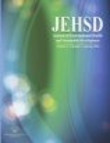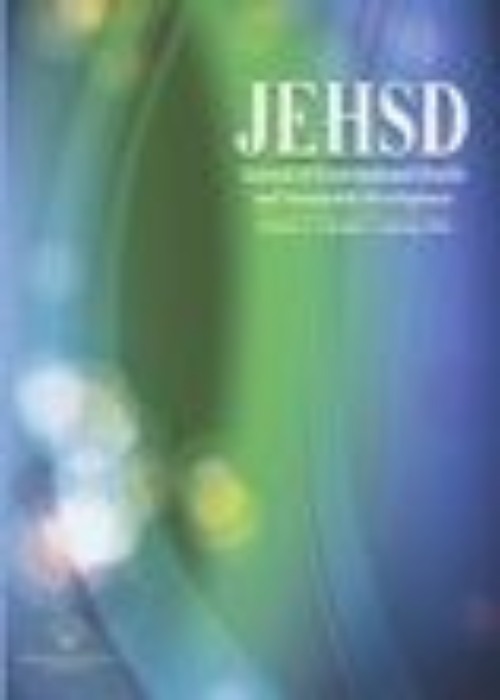فهرست مطالب

Journal of Environmental Health and Sustainable Development
Volume:8 Issue: 1, Mar 2023
- تاریخ انتشار: 1402/02/20
- تعداد عناوین: 8
-
-
Pages 1865-1866
-
Pages 1867-1877Introduction
The present study aims to evaluate adverse health effects caused by the use of wastewater for the irrigation of fields in Qom province, Iran.
Materials and MethodsAn environmental monitoring program was designed for 3 pathogens-Escherichia coli, Vibrio cholerae, and E. coli O157 and carried out on 120 samples from raw wastewater, effluent, and irrigated products with wastewater. In the next phase, exposure assessment and microbial risk assessment were performed using a questionnaire and interviewing 200 participants.
ResultsConcentrations of E. coli, V. Cholerae, and E. coli O157:H7 in raw wastewater were determined to be 3.4 × 103 ± 500 cfu/100ml, 2.1 × 103 ± 100 cfu/100ml, and 312 cfu/100ml, respectively. Concentrations of E. coli, V. Cholerae, and E. coli O157:H7 in effluent were determined to be 2.1 × 103 ± 100 cfu/100ml, 0.8 × 103 ± 100 cfu/100ml, and 176 cfu/100ml, respectively. The conventional wastewater treatment system was effective in removing E. coli, V. Cholerae, and E. coli O157: H7 by 50%, 59%, and 43%, respectively. Crops irrigated with effluent contained 400 ± 250 cfu/100ml, 0.1 × 103 ± 0.019 cfu/100ml, and 52 cfu/100ml of E. coli, V. Cholerae, and E. coli O157:H7, respectively. According to the exposure scenarios, the total annual probability of infection in the studied population for E. coli, V. Cholerae, and E. coli O157:H7 was determined to be 8 × 10-2, 8 × 10-4, and 17 × 10-2, respectively.
ConclusionsIn irrigating agricultural crops with wastewater implementing wastewater safety plans (WWSP) is crucial.
Keywords: Wastewater, Vibrio Cholerae, Escherichia Coli O157, Qom City, Crops, Agricultural -
Pages 1878-1896Introduction
The probability of contamination is frequently elevated in scenarios where a well and pit latrine coexist, or in situations where heavy rain causes the overflow of open excreta dumps, which in turn flush into wells and surface water. Many possible negative health effects might arise from exposure to various ecological and biological agents in the environment. Therefore, there is a need to examine the risk of disease transmission in Ife North Local Government Area (LGA) of Osun state, using epidemiological, environmental, and ecological factors.
Materials and MethodsGeostatistical analysis was used to examine the epidemiological risk, based on various environmental, biological, and ecological variables. The technique employed demonstrated the complexity and multiple parameters that raise the probability of an epidemic. The Shapiro-Wilk test was used to determine whether or not the data were normally distributed. Fuzzy logic, correlation, and spline surface interpolation analysis were conducted using ArcGIS 10.3 and ENVI 5.0 software. Three levels of epidemic risk were used to construct the disease surveillance and projection maps.
ResultsAccording to the final susceptibility map, 8.08 km2 of 460.12 km2 of the research area were considered to be at very low risk for an epidemic, followed by 364.98km2 of low risk and 87.06km2 of moderate risk areas, with percentages of 1.75%, 79.32%, and 18.92%, respectively.
ConclusionA very substantial correlation was observed between biological and ecological components and water-borne diseases. It is, therefore, advised that all water sources be treated before consumption, and community involvement be encouraged in environmental sanitation programs.
Keywords: Sanitation, Biological Factors, Fuzzy Logic, Epidemiology -
Pages 1897-1914Introduction
By substituting conventional fossil fuels, biofuel can emerge as a potential sustainable energy source with favorable environmental outcomes. Biodiesel, in particular, is increasingly attracting attention due to its high potential to increase the consumption of biofuel and contributing to sustainable development. Experimental studies have revealed that biodiesel can play a considerable role of biodiesel in improving petroleum-based characteristics.
Materials and MethodsPhysicochemical properties of pure biodiesel produced through esterification and transesterification, petroleum diesel, and biodiesel-diesel blends were experimentally measured. Ninety percent of the filtered and dried waste cooking oil (WCO) was converted to biodiesel, and it was shown that cetane index, flash point, and fire point increased by applying B10 (10% biodiesel + 90% petrodiesel) instead of petrodiesel.
ResultsB10 exhibited an adequate depression in pour point and cloud point by 6°C and 3°C at low temperature, respectively. Also, in this study, an economical study and a sensitivity analysis of a biodiesel production plant from WCO with a capacity of 90 tons per day was carried out, using COMFAR III software. The highest proportion of operating cost belonged to WCO (75%) followed by methanol (10%) and machinery, service, and maintenance expense (5%).
ConclusionBiodiesel showed a positive influence on petrodiesel characteristics, in which the desired green fuel contributed to save the environment. Eventually, economic analysis provides the possibility of running a plant in Iran as a sustainable solution to energy issues.
Keywords: Environmental Impact, Biofuel, Sustainable Development, Physicochemical Properties, Economic Analysis -
Pages 1915-1922Introduction
Chronic exposure to Arsenic (As) can increase the risk of diabetes mellitus. This study aims to determine the relationship between exposure to the As by drinking water and the prevalence of diabetes mellitus in two urban populations of Rafsanjan and Kashkuyeh, Iran, in 2020.
Materials and MethodsIn this research, 120 participants from Rafsanjan and Kashkuyeh were recruited and divided into four groups. The first two groups have lived in Rafsanjan and Kashkuyeh for the past 10 years, and the second two groups have lived in these two cities for less than a year. Individuals with two episodes of fasting blood glucose (FBG) ≥ 126 mg/dl were considered to have diabetes.
ResultsAs was found in high levels in all samples (10 samples) in Rafsanjan and 55% of samples (10 samples) in Kashkuyeh. The prevalence of diabetes was significantly higher in people with a residence duration of more than 10 years (p = 0.038). The analysis of Multiple Logistic Regression model demonstrated that the chance of developing diabetes in people who had lived in either city for more than 10 years was almost 5.7 times higher than others (OR = 5.79; P = 0.003). Also, the chance of developing diabetes was 91% higher in people who had lived in Rafsanjan compared with Kashkuyeh, and 91% higher in men than in women (OR = 1.915; P = 0.215).
ConclusionChronic exposure (≥ 10 years) to high levels of As by drinking water can increase the risk of diabetes, and future research is needed in this regard.
Keywords: Arsenic, Diabetes Mellitus, Drinking Water, Health -
Pages 1923-1937Introduction
To improve current practices and create the most effective healthcare waste treatment system, solid medical waste composition needs to be analyzed. This study aims to develop models to predict the rate of medical waste production in hospitals in Hilla city, Iraq. Predictive mode can be used to set standards, evaluate current methods for treating and disposing medical waste, and optimize healthcare solid waste management systems.
Materials and MethodsPredictive models and long-term data on the composition and rate of solid medical waste generation were developed using a longitudinal study design. A standardized questionnaire and weighted scale were used to measure solid medical waste generated from the five public hospitals. Statistics were used to create models predicting the amount of waste generated at each hospital.
ResultsThese models demonstrated a significant correlation between inpatient and outpatient numbers and waste generation. Different hospitals treat different numbers of inpatients and outpatients. Different models have been created based on various types of hospitals.
ConclusionLinear rule-based models accurately represent the weights of variables, identify the sources and implications of solid medical waste, and control waste levels by using a variety of parameters. The research model can help in the development of an effective strategic plan for setting up a medical solid waste (MSW) management system.
Keywords: Medical Waste, Solid Waste, Waste Management, Mathematical Model, Statistical, Iraq -
Pages 1938-1948Introduction
Drought is a slow-onset natural disasters and a gradual concern. Throughout the centuries, Iranians have applied various methods to preserve water resources and adjust themselves to the drought. This study was conducted with the aim of preserving water resources by households during a drought with the approach of indigenous knowledge.
Material and MethodsThe study was carried out from April 2017 to June 2018. A qualitative content analysis method was used to obtain insight into personal experiences. A purposive sampling method was used to select 15 participants. The research population consisted of native villagers who lived in rural areas near the three main plains of Yazd province (Yazd-Ardakan plain, Abarkouh plain, and Herat Va Marvast plain). Thematic analysis was used to analyze the data.
ResultsThe components related to indigenous knowledge were placed in 4 categories and 15 sub-categories. The main categories were personal hygiene, conservation of scarce resources, prediction of drought, and classification of water in terms of quality and its supply sources.
ConclusionIndigenous knowledge reflects several generations of experience. This knowledge is a valuable resource about how local communities interact with their ever-changing environments. We must pay attention to personal health behaviors and how our ancestors used and preserved scarce resources. It is necessary to identify and correct these behaviors and support them through proper management and financial resources at the community level. To preserve water resources in droughts, it is essential to use appropriate management and policy-making and motivational methods, and educate families.
Keywords: Droughts, Natural Disasters, Indigenous People, Drinking Water


